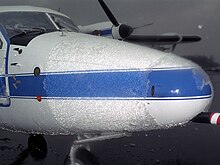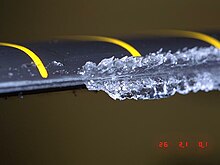Freezing rain is rain maintained at temperatures below freezing by the ambient air mass that causes freezing on contact with surfaces. Unlike a mixture of rain and snow or ice pellets, freezing rain is made entirely of liquid droplets. The raindrops become supercooled while passing through a sub-freezing layer of air hundreds of meters above the ground, and then freeze upon impact with any surface they encounter, including the ground, trees, electrical wires, aircraft, and automobiles. The resulting ice, called glaze ice, can accumulate to a thickness of several centimeters and cover all exposed surfaces. The METAR code for freezing rain is FZRA.

The Fokker F28 Fellowship is a twin-engined, short-range jet airliner designed and built by Dutch aircraft manufacturer Fokker.

Air Florida Flight 90 was a scheduled U.S. domestic passenger flight operated by Air Florida from Washington National Airport to Fort Lauderdale–Hollywood International Airport, with an intermediate stopover at Tampa International Airport. On January 13, 1982, the Boeing 737-222 registered as N62AF crashed into the 14th Street Bridge over the Potomac River just after take off from Washington National Airport.

Blown flaps, or jet flaps, are powered aerodynamic high-lift devices used on the wings of certain aircraft to improve their low-speed flight characteristics. They use air blown through nozzles to shape the airflow over the rear edge of the wing, directing the flow downward to increase the lift coefficient. There are a variety of methods to achieve this airflow, most of which use jet exhaust or high-pressure air bled off of a jet engine's compressor and then redirected to follow the line of trailing-edge flaps.
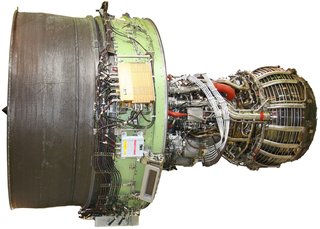
The General Electric GEnx is an advanced dual rotor, axial flow, high-bypass turbofan jet engine in production by GE Aerospace for the Boeing 747-8 and 787. The GEnx succeeded the CF6 in GE's product line.
Bleed air is compressed air taken from the compressor stage of a gas turbine, upstream of its fuel-burning sections. Automatic air supply and cabin pressure controller (ASCPC) valves bleed air from low or high stage engine compressor sections; low stage air is used during high power setting operation, and high stage air is used during descent and other low power setting operations. Bleed air from that system can be utilized for internal cooling of the engine, cross-starting another engine, engine and airframe anti-icing, cabin pressurization, pneumatic actuators, air-driven motors, pressurizing the hydraulic reservoir, and waste and water storage tanks. Some engine maintenance manuals refer to such systems as "customer bleed air".

Deicing is the process of removing snow, ice or frost from a surface. Anti-icing is the application of chemicals that not only deice but also remain on a surface and continue to delay the reformation of ice for a certain period of time, or prevent adhesion of ice to make mechanical removal easier.

USAir Flight 405 was a regularly scheduled domestic passenger flight between LaGuardia Airport in Queens, New York City, New York, and Cleveland, Ohio. On March 22, 1992, a USAir Fokker F28, registration N485US, flying the route, crashed in poor weather in a partially inverted position in Flushing Bay, shortly after liftoff from LaGuardia. The undercarriage lifted off from the runway, but the airplane failed to gain lift, flying only several meters above the ground. The aircraft then veered off the runway and hit several obstructions before coming to rest in Flushing Bay, just beyond the end of the runway. Of the 51 people on board, 27 were killed, including the captain and a member of the cabin crew.

Air Ontario Flight 1363 was a scheduled Air Ontario passenger flight which crashed near Dryden, Ontario, on 10 March 1989 shortly after takeoff from Dryden Regional Airport. The aircraft was a Fokker F28-1000 Fellowship twin jet. It crashed after only 49 seconds because it was not able to attain sufficient altitude to clear the trees beyond the end of the runway, due to ice and snow on the wings.
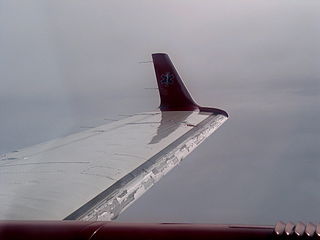
In aviation, icing conditions are atmospheric conditions that can lead to the formation of water ice on an aircraft. Ice accretion and accumulation can affect the external surfaces of an aircraft – in which case it is referred to as airframe icing – or the engine, resulting in carburetor icing, air inlet icing or more generically engine icing. These phenomena may possibly but do not necessarily occur together. Both airframe and engine icing have resulted in numerous fatal accidents in aviation history.
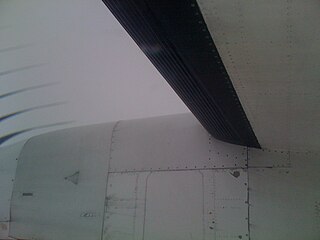
A deicing boot is a type of ice protection system installed on aircraft surfaces to permit a mechanical deicing in flight. Such boots are generally installed on the leading edges of wings and control surfaces as these areas are most likely to accumulate ice and any contamination could severely affect the aircraft's performance.
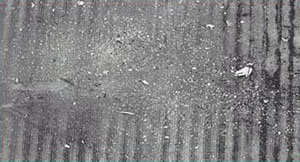
American Eagle Flight 4184, officially operating as Simmons Airlines Flight 4184, was a scheduled domestic passenger flight from Indianapolis, Indiana to Chicago, Illinois, United States. On October 31, 1994, the ATR 72 performing this route flew into severe icing conditions, lost control and crashed into a field. All 68 people aboard were killed in the high-speed impact.

The Cessna Citation II are light corporate jets built by Cessna as part of the Citation family. Stretched from the Citation I, the Model 550 was announced in September 1976, first flew on January 31, 1977, and was certified in March 1978. The II/SP is a single pilot version, the improved S/II first flew on February 14, 1984 and the Citation Bravo, a stretched S/II with new avionics and more powerful P&WC PW530A turbofans, first flew on April 25, 1995. The United States Navy adopted a version of the S/II as the T-47A. Production ceased in 2006 after 1,184 of all variants were delivered.
In ground deicing of aircraft, aircraft deicing fluid (ADF), aircraft deicer and anti-icer fluid (ADAF) or aircraft anti-icing fluid (AAF) are commonly used for both commercial and general aviation. Environmental concerns include increased salinity of groundwater where de-icing fluids are discharged into soil, and toxicity to humans and other mammals.

The Cessna Citation V is a business jet built by Cessna that was in production from 1989 until 2011. During that time, 774 such craft were made. The first Model 560 prototype, a stretched version of the Citation S/II, flew in August 1987 and was certified on December 9, 1988.
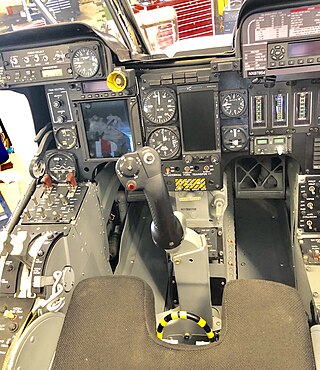
Aircraft systems are those required to operate an aircraft efficiently and safely. Their complexity varies with the type of aircraft.

The 1971 January 22 Surgut Aeroflot Antonov An-12 crash occurred on 22 January 1971, when an Aeroflot Antonov An-12B, registered CCCP-11000, flying from Omsk Tsentralny Airport, in the Soviet Union's (RSFSR), crashed 15 km (9.3 mi) short of the runway on approach to Surgut International Airport, Surgut, RSFSR. An investigation found the aircraft's ice protection system was ineffective because the engine bleed air valves were closed during the flight; ice therefore built up on the aircraft causing it to go out of control.

The Clean Sky Joint Undertaking (CSJU) is a public-private partnership between the European Commission and the European aeronautics industry that coordinates and funds research activities to deliver significantly quieter and more environmentally friendly aircraft. The CSJU manages the Clean Sky Programme (CS) and the Clean Sky 2 Programme (CS2), making it Europe's foremost aeronautical research body.

The Commuter Aircraft Corporation CAC-100 was a 50–60 seat, four-engined, turboprop commuter airliner developed in the United States in the late 1970s and early 1980s.

In aviation, ground deicing of aircraft is the process of removing surface frost, ice or frozen contaminants on aircraft surfaces before an aircraft takes off. This prevents even a small amount of surface frost or ice on aircraft surfaces from severely impacting flight performance. Frozen contaminants on surfaces can also break off in flight, damaging engines or control surfaces.
